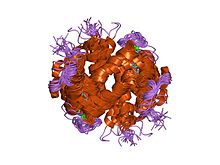F-actin capping protein
| F-actin capping protein alpha subunit | |||||||||
|---|---|---|---|---|---|---|---|---|---|
 solution nmr structure of s100b bound to the high-affinity target peptide trtk-12 | |||||||||
| Identifiers | |||||||||
| Symbol | F-actin_cap_A | ||||||||
| Pfam | PF01267 | ||||||||
| InterPro | IPR018315 | ||||||||
| PROSITE | PDOC00609 | ||||||||
| SCOP2 | 1izn / SCOPe / SUPFAM | ||||||||
| |||||||||
| F-actin capping protein, beta subunit | |||||||||
|---|---|---|---|---|---|---|---|---|---|
| Identifiers | |||||||||
| Symbol | F_actin_cap_B | ||||||||
| Pfam | PF01115 | ||||||||
| InterPro | IPR001698 | ||||||||
| PROSITE | PDOC00203 | ||||||||
| SCOP2 | 1izn / SCOPe / SUPFAM | ||||||||
| |||||||||
In molecular biology, the F-actin capping protein is a protein which binds in a calcium-independent manner to the fast-growing ends of actin filaments (barbed end), thereby blocking the exchange of subunits at these ends. Unlike gelsolin and severin this protein does not sever actin filaments. The F-actin capping protein is a heterodimer composed of two unrelated subunits: alpha and beta. Neither of the subunits shows sequence similarity to other filament-capping proteins.[1] The alpha subunit is a protein of about 268 to 286 amino acid residues and the beta subunit is approximately 280 amino acids, their sequences are well conserved in eukaryotic species.[2]
The actin filament system, a prominent part of the cytoskeleton in eukaryotic cells, is both a static structure and a dynamic network that can undergo rearrangements: it is thought to be involved in processes such as cell movement and phagocytosis, as well as muscle contraction.[1]
References
- ^ a b Maruyama K, Kurokawa H, Oosawa M, Shimaoka S, Yamamoto H, Ito M, Maruyama K (May 1990). "Beta-actinin is equivalent to Cap Z protein". J. Biol. Chem. 265 (15): 8712–5. PMID 2341404.
{{cite journal}}: CS1 maint: multiple names: authors list (link) - ^ Cooper JA, Caldwell JE, Gattermeir DJ, Torres MA, Amatruda JF, Casella JF (1991). "Variant cDNAs encoding proteins similar to the alpha subunit of chicken CapZ". Cell Motil. Cytoskeleton. 18 (3): 204–14. doi:10.1002/cm.970180306. PMID 1711931.
{{cite journal}}: CS1 maint: multiple names: authors list (link)
